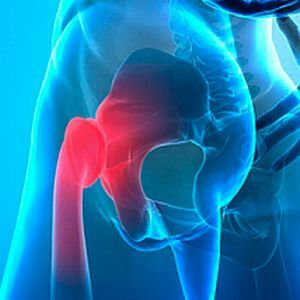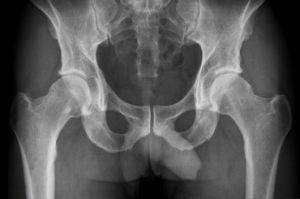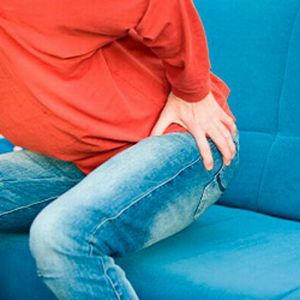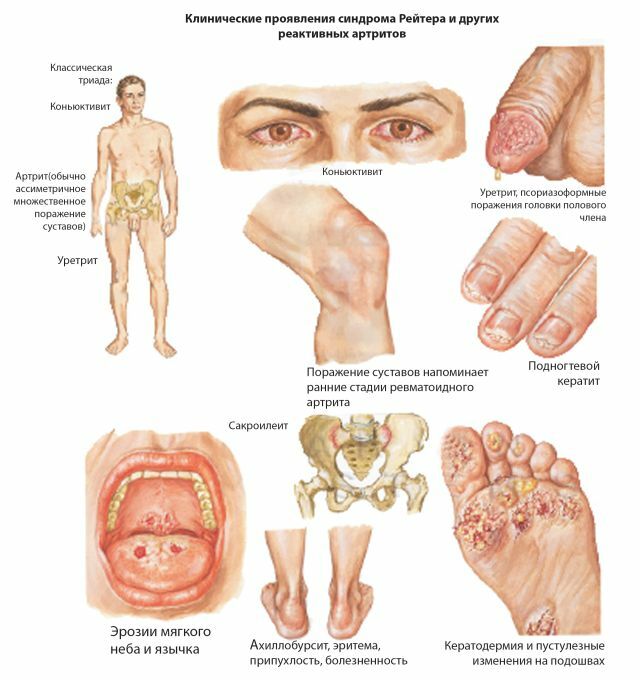 The hip joint, which is the most massive in the body, performs a very important function, connecting the thighbones of the legs with the pelvis, allowing the person to move.
The hip joint, which is the most massive in the body, performs a very important function, connecting the thighbones of the legs with the pelvis, allowing the person to move.
For this reason, this joint has a high load, comparable to the total load on the spine along its entire length.
Arthritis can significantly weaken the joint and deliver many problems, and in severe cases, exclude the possibility of movement of the lower limbs.
That's why it's important to diagnose it in a timely manner and start treatment as soon as possible, without allowing any complications.
Article Contents
- Features diseases
- Causes
- disease Symptoms
- The diagnosis
- Features disease in
- children Reactive coxitis children
- Therapy disease
- Traditional recipes
- Possible complications
- Prevention
- Conclusions
Features diseases
Arthritis of the hip joint( coke) occurs, usually after reaching a man of forty years of age, but the manifestation of the disease can be seen in childrenand adolescents, and young people.
In this case, women are more often exposed to the disease than men.
This disease can affect both one and both hip joints at once, but in most cases of bilateral arthritis, one of the joints is first affected, which after a while "pulls" the second, still healthy.
Modern medicine distinguishes several varieties of arthritis, each of which has its own characteristics:
- Nonspecific .The appearance of this species is provoked by the activity of bacterial infections.
- Specific .Caused by diseases such as syphilis, gonorrhea and tuberculosis.
- Rheumatoid .This variety affects both hip members.
- Reactive .The development of the disease in this case is characterized as a reaction to the transmitted infectious diseases, usually within two to three weeks after the disease.
- Transistor .Occurs as a consequence after an inflammatory process or an injury, affects mainly the children.
The above forms of coxitis of the hip joint are symptomatic.
Causes of the disease
Arthritis can be caused by various causes, the most common of which are: 
- complications of acute and chronic diseases , having an infectious nature;
- excessive and prolonged physical activity , which cause the condition of the pathological condition of fatigue of the hip joints;
- metabolic disorders and malfunctions in the body metabolism, the deposition of salts in the joints;
- autoimmune mode of the body , as a result of which the human immune system begins to terrorize its own tissues and organs.
In addition to these reasons, provoking the disease, there are others - suffered injuries, severe hypothermia, malfunctioning of the nervous system and so on.
Symptoms of the disease
The manifestations of arthritis of the hip largely depend on its variety, the list of which is indicated above, but there is a common symptom for all forms - - aching sensations in the pelvis, groin and buttocks .
Their intensity increases by the morning, also noticeable discomfort during getting up from the sitting position and with the body tilts.
Quite often there is hyperemia, which causes reddening of the skin around the site of the disease. Pressing on the affected area causes pain, the ability to move the foot without pain is completely or partially absent.
In severe cases, joints of joint surfaces and muscle atrophy are possible.
Due to the fact that the coxitis of the hip joint affects a large area of the musculoskeletal system, its course is often accompanied by manifestations of general intoxication at the organism level, fever, increased weakness, and temperature.
The severity of symptoms characteristic of the disease is directly related to the severity of its course:
- Acute( as well as subacute) - a sharp formation of pain and rapid loss of joint mobility. It is characterized by severe leakage and seriously disrupts the body's functions, after which it can smoothly change into a chronic form.
- Chronic - is characterized by a periodisation of the periods of remission and exacerbation of symptoms, as well as the gradual development of irreversible effects that can lead to permanent immobility of the joint.
Specific manifestations of each of the common forms of the disease should also be indicated:
- Purulent - symptoms are similar to general intoxication, weakness, high sweating and fever are observed. Possible accumulation of pus in the joint area, which further exacerbates the state of the body.
- Rheumatoid is a parallel lesion, puffiness and stiffness of both joints, as well as prolonged pain attacks, which can last up to ten consecutive days, after which they subside.
- Psoriastically th. It is characterized by uneven joint damage, blue skin in their area, and also its roughness.
Diagnosis of
 The diagnosis of coxitis is not something terrible, as this disease is quite successfully treatable, especially in the early stages of leakage.
The diagnosis of coxitis is not something terrible, as this disease is quite successfully treatable, especially in the early stages of leakage.
This diagnosis is most often carried out by the elderly, but children and middle-aged people are at risk.
It is also possible to avoid the development of this disease by engaging in its prevention, which everyone can do.
Features of the disease in children
Hip arthritis manifests itself not only in adults, but in children.
Diagnosis of this disease is difficult because the child is often unable to adequately assess their health and indicate the source and nature of pain.
It is very important to start the timely treatment of childhood arthritis, since joint damage at an early age can leave an indelible imprint on the entire subsequent life of a person.
Fortunately, a non-surgical treatment of this disease in a child is possible.
Reactive cocytite in children
This name hides an inflammatory, non-plague joint disease that occurs when a child has an infectious disease.
It manifests itself as a sharp deterioration in the general condition of the body, there are also signs of intoxication, an increase in body temperature and some other symptoms.
Treatment of children reactive arthritis of the hip joint is carried out in three ways:
- pathogenetic;
- eniotrope;
- is symptomatic.
For more effective treatment, the above methods are used in combination.
Therapy of the disease
The main goal of treating hip arthritis is to sanitize the focus of the infection, as well as the complete restoration of the  functions that a healthy joint should perform.
functions that a healthy joint should perform.
After achieving the result, a therapeutic massage is usually prescribed to promote health.
As a rule, two main methods are used to cure the disease:
- Medication - involves the passage of a course of non-steroidal anti-inflammatory drugs to patients. To increase the effectiveness of treatment, the reception of funds is accompanied by injections of glucocorticoids into the joint, but only in cases where acute pain is observed in the area of inflammation.
- Surgical - the affected joint is replaced with a prosthesis in a situation where conservative treatment techniques for a long time do not bring the expected result.
Folk recipes
You can also go to folk medicine. Effective effect is provided by baths, including bran or sea salt.
Often used sea sand, baths with coniferous solution, ointments from birch buds and turpentine. These methods are well suited for the prevention and elimination of pain, but nevertheless one should consult a doctor.
Possible complications of
Also in the last stages of patients, lameness, elongation or shortening of the limb attached to the affected joint, prolonged pain is observed. Rapidly progressive arthritis can lead to atrophy of the muscles of the hips and groin.
Prevention
The disease can be prevented.
For this it is necessary to follow the following points, preferably all at the same time:
- adequate physical activity;

- healthy and adequate nutrition;
- own weight control;
- protection of joints from excessive cooling;
- use comfortable shoes.
Thus, maintaining a healthy lifestyle can significantly reduce the risk of this dangerous disease.
Conclusions
Many people delay the treatment of the coke, then get lameness, severe pain in the pelvic region, general deterioration of the body and the risk of getting a disability.
For this reason, do not delay treatment and consult a doctor when the first symptoms appear, especially when it comes to a child.



